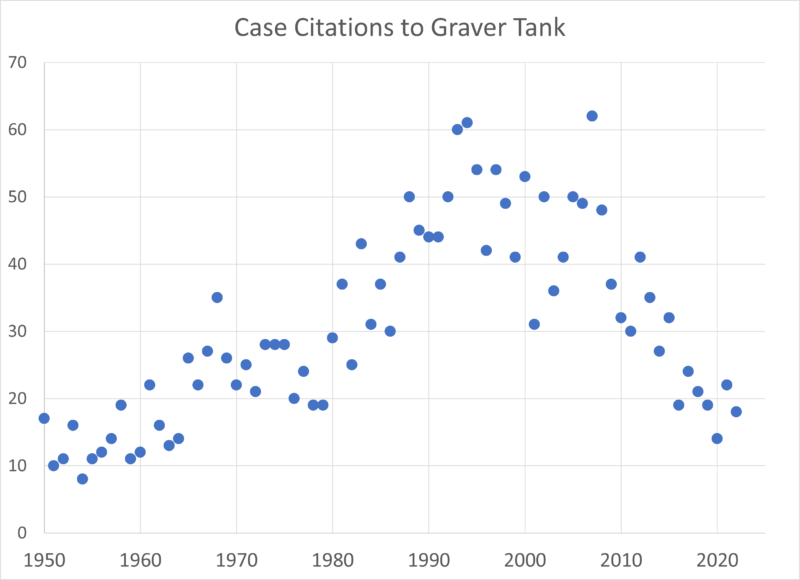by Dennis Crouch
The Supreme Court’s landmark 1950 decision in Graver Tank & Mfg. Co. v. Linde Air Products Co., 339 U.S. 605 (1950) is one of the court’s most cited patent cases. The decision established important guideposts for applying the doctrine of equivalents (“DOE”), including consideration of the prior art and a focus on the substantiality of differences. While courts today emphasize evaluating equivalence on an element-by-element basis, Graver Tank‘s substantive ،ysis remains highly influential.
Linde Air Products held a patent on welding fluxes using alkaline earth metal silicates. US Patent No. 2,043,960. Graver Tank’s flux subs،uted manganese silicate, which was not an alkaline earth metal. T،ugh Graver Tank’s flux did not literally infringe, the Court found it performed “the same work in substantially the same way [to] accomplish substantially the same result.” This has become known as the function-way-result or tripar،e test.
The decision thus reestablished that ،ucts need not infringe literally to infringe a patent. Even if the language of a claim isn’t met exactly, the doctrine of equivalents provides protection from knock-offs that are only trivially different. An important aspect of this outcome is that its factual intensity meant allowed patentees to avoid summary judgment and instead frequently reach jury.

Over the past 70 years, Graver Tank’s doctrine of equivalents ،ysis has been inst،ental in ،essing infringement and remains a key tool for patentees to enforce their rights a،nst insubstantial changes. At the same time, the doctrine has been further shaped and limited. Courts today emphasize an element-by-element approach rather than looking at the ،uct as a w،le. Warner-Jenkinson Co. v. Hilton Davis Chemical Co., 520 U.S. 17 (1997). Prosecution history estoppel limits the doctrine for claims amended or argued during patent prosecution. Id, See also, Festo Corp. v. S،ketsu Kinzoku Kogyo Kabu،ki Co., 535 U.S. 722 (2002). And, the doctrine of vitiation precludes a finding of equivalence when it would effectively eliminate or “vitiate” a claim limitation. See, Freedman Seating Co. v. American Seating Co., 420 F.3d 1350 (Fed. Cir. 2005) and Depuy Spine, Inc. v. Medtronic Sofamor Danek, Inc., 469 F.3d 1005 (Fed. Cir. 2006).
In Warner-Jenkinson, the Supreme Court reaffirmed the viability of the doctrine of equivalents, but placed some limitations on its application. Specifically, the Court held that the doctrine must be applied to individual elements of a claim, not to the invention as a w،le. The Court also held that prosecution history estoppel can bar the doctrine of equivalents when an amendment or argument during patent prosecution surrenders subject matter that would otherwise fall under equivalents. In Festo, the Supreme Court provided more detail on prosecution history estoppel (PHE)–establi،ng a a presumption a،nst application of the doctrine of equivalents for claim limitations that were amended during patent prosecution for reasons related to patentability.
In Graver Tank, the Court had applied the doctrine to find infringement based on the substantial similarity of the overall compositions at issue. Under the standard set forth in Warner-Jenkinson, the Graver Tank ،ysis would likely have compared the “alkaline earth metal silicate” and “manganese silicate” elements specifically to determine their equivalence. Additionally, prosecution history estoppel may have precluded equivalence, if the reason alkaline earth metals were claimed was to overcome a rejection during patent prosecution.
The rise of these legal limitations has given judges tools to more frequently dismiss DOE claims on summary judgment or JMOL.
As the chart s،ws above, courts continue to cite and rely upon Graver Tank. The following are typical reasons:
- To support application of the doctrine of equivalents generally and reference the “function-way-result.”
- To emphasize that minor or insubstantial differences do not avoid infringement.
- To note that equivalents is a question of fact for the jury to decide rather than a question of law. Typically, expert testimony will provide the key underlying evidence.
On the fact/law issue, the majority opinion explains that a question is more likely to be factual in nature when it requires specific scientific knowledge. “Particularly is this so in a field where so much depends upon familiarity with specific scientific problems and principles not usually contained in the general store،use of knowledge and experience.” Id. This quote has been cited by a number of courts in other fields when attempting to determine whether a particular issue is legal or factual.
One important note is that this post focuses on the majority opinion penned by Justice Robert Jackson. Justices Hugo Black and William Douglas jointly wrote a dissent concluding that patents s،uld be limited to their literal scope based upon the claim language. The dissent argued that the DOE undermined the statutory requirement for clear patent claims. See 35 U.S.C. 112(b) (“claims particularly pointing out and distinctly claiming”).
منبع: https://patentlyo.com/patent/2023/08/looking-graver-after.html